Easy to Draw a Foxtail Plant Easy to Draw Marsh Grass

Search Wild Foods Home Garden & Nature's Restaurant Websites:
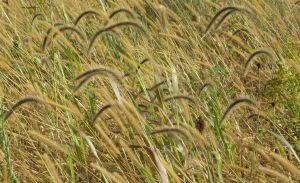
(NOTE: If you are not interested in growing Bristly Foxtail, but just finding the plant and using the grain, try going to the Nature's Restaurant Online site for Bristly Foxtail.)
There are a few different plants in the Bristly Foxtail Family. And just to confuse matters, there are other grasses called Foxtails. A warning: Some of the other grasses called "Foxtail" are dangerous to animals, especially dogs & cats. For more information, follow pages on this Google search link: foxtail grass dogs. Most often, the dangerous ones are on the western side of North America, but not always - I have found them in Ontario. The dangerous ones are in the family Hordeum, while the Bristly Foxtail I'm writing about for grain is from the family Setaria. Sadly, many websites show pictures of the wrong one - this is why it is always important not to trust the "common" names, and double check with the Latin names. By the way, if you have horses, grow any of the Millet varieties where the horses can't eat them.
The Bristly Foxtails are the wild ancestors of two Millet grains grown as grain crops in Asia. What I don't understand is why this is not a better regarded food grain. It is good tasting in all three I list below, prolific, almost ignores drought, and does well on soils that are tougher for other plants. In all honesty, I'm the only person I know that eats these wild "noxious weed" grains. Other wild food experts don't mention these Bristly Foxtails as far as I'm aware. I can't find any recipes on the web that mention them unlike almost any other wild food, and that is odd, because some people eat really awful plants like the Garlic Mustard and the Pokeweed, and even the carcinogenic Bracken Fiddle heads and Canada Ginger, yet here we have a tasty, nutritious, wild grain that is the wild cousin of the commercially grown Millet, and nothing. Maybe there is something I don't know.
As far as growing them goes, you first have to make sure it is legal where you live. In some areas, it is listed as a noxious weed which means you can't grow them. They interfere with planted commercial soy and corn harvests. The reason they are considered noxious weeds is ironic - they grow very well in almost any soil and are not bothered by severe drought. I must see the world backwards, because to me, that makes them seem like a smart thing to grow on marginal soils where drought is common and water is scarce. Again, must be something I don't know.
I actually prefer the taste of the wild Foxtail myself, but in many cases it would be better to buy seed for the cultivated strains of them. There are a couple of reasons. One, you get more grain per area of land, second, they are bred so that the grain stays on the plant when ripe. Plant either commercial "Foxtail Millet" seed or "Pearl Millet" seed. If you have the choice, go for the Pearl. The plants are bigger and should re-seed themselves, and of course, they are legal to grow. There is one disadvantage to the commercial varieties - they require more nitrogen in the soil. Now, if you decide you want to grow the wild versions, each of the three has advantages and disadvantages. The Green Foxtail produces so fast, you can get at least two crops in per season - even in the northern areas. The Giant Foxtail gives you one crop per season, but you get more per crop, balancing it out. The Yellow Foxtail is the closest one to the commercially grown varieties, and in fact shares some of the same Latin names. This one is the one commercial Millet was derived from as I understand it, but it can do well on low nutrient soil and in drought.
Soil & Site: They do fine in soils that are a touch acidic to a bit alkaline. If you are planting the commercial types, put some nitrogen rich fertilizer or composted manure in the soil when you till or turn it. You can do the same for the wild varieties, but you don't need as much. This plant responds to nitrogen, so if you put more in, you can get more grain out. Because of the nitrogen draining from the soil aspect to Millet, it is a great crop to rotate with a nitrogen fixing plant. My personal two favorites for this are peas and beans - wax and green. Each crop produces food, so each year the soil is productive in your garden. If you decide to do this rotation instead of using fertilizer, I suggest using the commercial "Foxtail Millet" variety, as it tends not to self seed, so you won't have it growing though the beans or peas the next year.
Planting: Planting and growing any of these is about as easy as it comes. Just broadcast the seed over the turned and raked soil, lightly rake in, tamp down, water and leave. To be sure they take, you can water for a couple of days after planting, but one of the great things about this crop is how fast they sprout and grow. They will sprout in 2-4 days, and within a week should be able to be on their own without care.
Maintenance: None. I guess pull weeds out that grow around them, though that is kind of ironic with these.
Harvesting: Shattering (grain falling off when you touch the ripe seedhead) is more of an issue with wild plants, as one of the features cultivated plants are selected for is their ability to hold onto the grain without shattering. When the grain is ripe (it turns tan and dry) and the weather is dry, gather the seed heads and rub them around in a bucket with gloves on. Then pour the grain from bucket to bucket in front of a fan so that the grain lands in the lower bucket, and the chaff blows away. You can use a steady breeze as well. You have to get all the chaff out, so this will mean a few back and forth pours from bucket to bucket. When I gather the seedheads of the Giant Foxtail, I just walk around with a bucket and pair of scissors. The Giant Foxtails will be nodding over anyway, so just put the bucket below and snip off the seedhead. The other way I use, but more for the Green Foxtail, is to put something under the seedhead while on the plant - a cloth for instance - and just rub the seedhead between your hands over the cloth, then blow off the chaff. This is the method I use when out and just having a snack of fresh, ripe grain.
Using: So, how do you use them? You can snack on them raw, fresh off the plant. Make sure you chew them well. Don't eat too much, as they get more filling after 10-15 minutes after eating them, and too much can leave an indigestion feeling - like eating too much at Christmas or Thanksgiving meals - these grains are a very dense, protein rich food, so a little goes a long way. You can gather them, dry them, and store them like Millet you buy, and use them as if they were. You have to dry them well with warm air, or in a warm spot and laid out flat - if you don't, they will go mouldy - trust me.
For making them like rice there are two methods based on how you will use them. If you want sticky cooked grain for using in veggie burgers or making Cabbage Rolls, or Warak Arish use 2 1/4 cups water to a cup of dried grain, bring to a boil, turn down and simmer covered for about 45 minutes to an hour - until the water is gone and the grain is soft. If you want them light and fluffy and not sticky, good for serving with stir-fry's or in with salads, first lightly roast the dry grain in a hot pot constantly stirring around. When they are so hot, they start giving off steam and slightly changing color, put them in simmering water and cook at low for about 20 minutes. The water to grain ratio for the second way is 2:1.
After drying the grain, or fresh, or after lightly roasting as above, you can grind them into flour and mix with other flour you use at a rate of about 15% for bread. Each way tastes slightly different, but they give a distinct nutty flavor. When dry, they grind well in a coffee grinder or grain mill, but when fresh, they bog up the grain mill, so just use a coffee grinder for fresh grain. By the way, I mean one of those coffee grinders that have the spinning blade, sort of like a very tiny blender. They are usually between 10-20 dollars new, and are easy to find at most stores that carry small appliances.
They make a very good veggie burger. Make them like rice, the sticky way described above, add that to some finely chopped and fried or stir fried onions, garlic, carrots, parsley, basic, oregano, pepper and whatever else you want to try - including of course any wild veggies you may have gathered. Mix well the cooked grain and the cooked vegetables. Make into patties and fry, broil or bake. Use in burgers like you normally would after that. Very good. Some things to add while mixing are: crushed nuts (awesome with Hickory Nuts or Black Walnuts), sunflower seeds (very nice), tofu smashed up, boiled, drained and dried on a fresh tea towel, mashed chick peas or mashed kidney beans. With the beans, chick peas or tofu, you get a very good complete protein with the grain. Once you have made them into patties, you can freeze them by separating with wax paper and putting a few in baggies.
The Varieties: So, of the wild three, how do you know which is which? The Giant Foxtail nods, that is, the seedhead droops over giving it the alternate name "Nodding Foxtail". The Green Foxtail often nods too, but the Giant Foxtail is larger with much bigger leaves than the Yellow or Green Foxtail. If the seedhead is nodding and green, check the leaf upper surface. More often than not the Giant Foxtail leaf has small hairs on it, while the Green Foxtail does not. If still not sure, check the edges of the leaves. The Giant Foxtail has very tiny serrations on the leaf edges, while the Green Foxtail does not. Also, if the leaf edges are curled upward, it would be the Green Foxtail, but they don't always do that. With the Giant Foxtail the seedhead (flower spike) is always light to medium green when unripe, and light brown to tan when ripe or close to ripe. If the seedhead (flower spike) is yellowish before it is ripe, it is the Yellow Foxtail (Setaria glauca). If it is a reddish green or purplish green, it is most likely the Green Foxtail (Setaria viridis). If you find a green seedhead in the spring, it would be the Green Foxtail, as the Giant Foxtail won't grow the seedhead until summer - it is a warm weather grass, while the Green Foxtail can grow in cooler weather. If the seedheads are longer than 15 cm (6 inches), and the grain is spherical, you most likely have the Foxtail Millet (Setaria italica). The Foxtail Millet is the tallest of the group - up to 2 meters (6 feet) tall, with leaf blades that are wider - 3 cm (1 1/4 inches). If you do find it, you have the best of the bunch.
The two main commercial varieties you can ask for are the Panicum milliaceum, most often called Common Millet, or White Millet. This is the kind you tend to get when purchasing bird seed or buying grain from a health food store. The other main kind, the kind that is related to the wild ones is Setaria italica or Pennisetum glaucum. This is the one that has the varieties, Pearl Millet and Foxtail Millet.
Below is a description of the three you will find commonly growing in the wild in the Eastern side of North America.
Giant Foxtail (Setaria faberi). Synonyms for Setaria faberi: Setaria macrocarpa & Setaria autumnalis. Other common names include: Faber's Foxtail, Chinese Millet, Chinese Foxtail, Giant Bristlegrass, Japanese Bristlegrass and Nodding Foxtail. Not native to North America, it came from Asia, and is a hated weed of farmers, where it can really cut down on harvest of the intentional crop - especially corn.
This one has by far the largest grain size of all three listed here, plus each seedhead has a lot of grain. This one will be your best bet if you are harvesting to dry and use through the year if you have a choice.
Description:
- USDA Plant Hardiness Zone: no data, but grows almost everywhere crops are grown (More information on hardiness zones).
- Soil pH: no data, but does very well on neutral to slightly alkaline soils from observation
- Plant Size: 60-130 cm (2-4 feet) tall, often with multiple culms (stalks) from the base at the ground
- Duration: Annual
- Leaf Shape: Long, narrow, grass leaf blades
- Leaf Phyllotaxis (Arrangement) on branch: Alternate
- Leaf Size: Normally up to about 38 cm (15 inches) long and 2 cm (3/4 inch) wide - though I've seen larger - up to 3 cm (1 1/5 inches) wide, see picture below
- Leaf Margin: Extremely small Serrated (saw toothed edge)
- Leaf Notes: Usually the upper leaf surface has small hairs, sometimes no hairs.
- Flowers: At the termination of each culm there is a 7.5-15 cm (3 to 6 inches) long by close to 2 cm (3/4 inch) diameter, bottle-brush shaped panicle (cluster) of green florets (tiny flowers) that starts blooming in mid summer. Flower spike almost always tilted over or nodding - hence the name "Nodding Foxtail". The bristles that stick out can be reddish, but lightly so compared to how red the Green Foxtail can be.
- Fruit: Oval, flattened, yellow-tan to light brown grain about 2.75mm long, 1.75 mm wide, 1.00 mm thick.
- Stem: Round, light green, hairless.
- Habitat: Fields, waste areas, ditches. Full sun. Wherever the land is tilled or has been disturbed you are likely to find this grass.
Web Resources:
- Pictures on the web here (Google images) and here (Bing images).
- Interactive USDA distribution map and plant profile here.
- The Biota of North America Program (BONAP) distribution map here. BONAP map color key here.

Giant Foxtail (Setaria faberi), notice the huge leaf that looks like a small leaf from corn - this was an unusual 3 cm (1 1/5 inches) wide. I was waiting to eat the grains from this one, but when I went back to check on it one day, there was a truck parked right on it, and it was crushed - a good reason to grow your wild food at home.
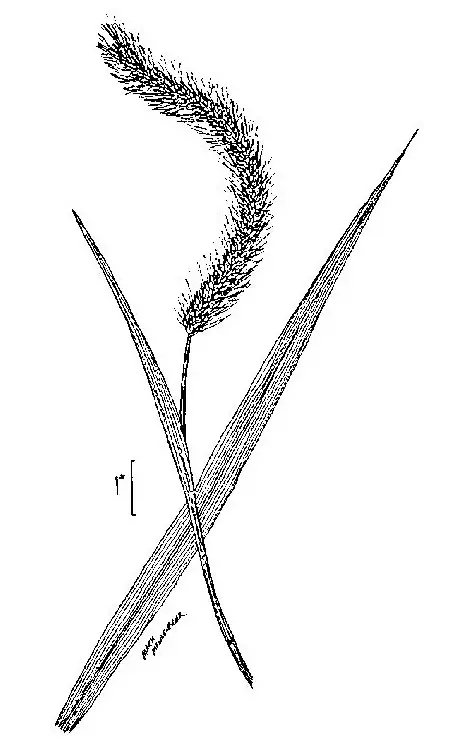
Giant Foxtail drawing showing leaf shape. (USDA-NRCS PLANTS Database / USDA NRCS. Wetland flora: Field office illustrated guide to plant species. USDA Natural Resources Conservation Service.)
Green Foxtail (Setaria viridis). Known also as green Bristlegrass. It is from Eurasia, and it too is a hated weed of farmers. This one can grow multiple generations per season unlike the Giant Foxtail - which means you can find ripe grain very early in the year, and right into fall. This one is your best bet for eating raw in small quantities when out walking or biking. You have to find it and harvest this one before it is fully ripe, because it drops the grain very quickly after ripening - the whole process of growing, ripening and dropping seed is on fast forward with this one. I really like this one raw, the grain has a rich, nutty taste and chewy texture fresh off the seedhead before it has had a chance to dry out. When I'm out walking or biking and see this ripe, I take a break to have some. Put a jacket or shirt on the ground under it, clasp it with both hands gently, lean it over the shirt and rub back and forth. Do this for about 5-10 seedheads, blow over it to blow away the chaff, and you have a nice snack with a few sips of water.
- USDA Plant Hardiness Zone: no data, but grows almost everywhere crops are grown (More information on hardiness zones).
- Soil pH: no data, but does very well on neutral to slightly alkaline soils from observation
- Plant Size: Between 45-60 cm (1 1/2 to 2 feet) tall with multiple culms (stalks) from the base at the ground. In areas of dense plant growth, culms are few and close, whereas in open areas, they are wide spreading a many.
- Duration: Annual
- Leaf Shape: Long, narrow, grass leaf blades
- Leaf Phyllotaxis (Arrangement) on branch: Alternate
- Leaf Size: Up to 15 cm (6 inches) long and 13 mm (1/2 inch) wide
- Leaf Margin: Entire (smooth edged)
- Leaf Notes: hairless, often but not always the margins of the leaf are curled upward
- Flowers: 5-10 cm (2 to 4 inches) long by 13 mm (1/2 inch) wide bottle-brush shaped. Can bloom from spring to fall. Panicle (cluster) of green florets (tiny flowers) at the top of the each culm that starts blooming in mid summer. Sometimes overall color is green, sometimes a reddish or purplish hue. Sometimes upright, sometimes nodding.
- Fruit: Oval, light off-white to darker tan to light brown (though I have found some that were almost black), around 1.5 mm long, by 0.75 mm wide.
- Stems: Round, light green, hairless
- Habitat: Almost anywhere it can get full to part sun.
Web Resources:
- Pictures on the web here (Google images) and here (Bing images).
- Interactive USDA distribution map and plant profile here.
- The Biota of North America Program (BONAP) distribution map here. BONAP map color key here.
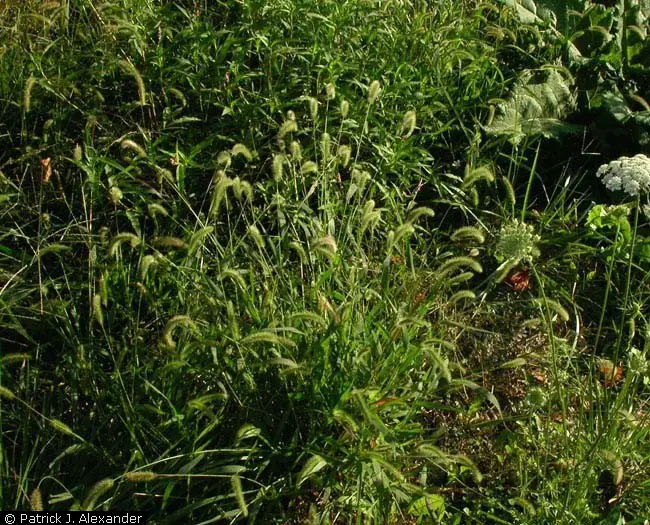
Typical clump of Green Foxtail. (Patrick J. Alexander, hosted by the USDA-NRCS PLANTS Database)
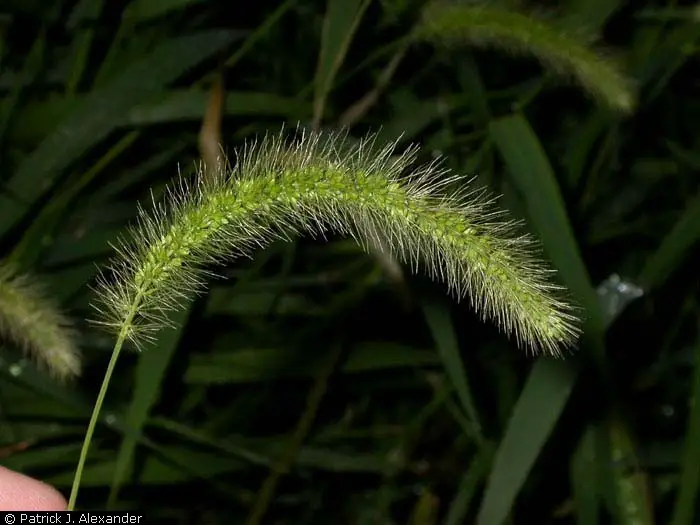
Green Foxtail unripe. (Patrick J. Alexander, hosted by the USDA-NRCS PLANTS Database)
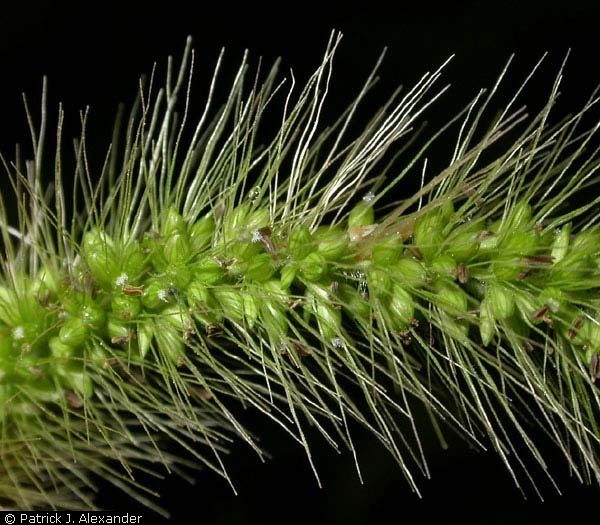
Green Foxtail unripe close up. (Patrick J. Alexander, hosted by the USDA-NRCS PLANTS Database)

Green Foxtail (Setaria viridis). This one is ready to harvest, in fact, it has already lost some grain - a few days before would have been better.

The grain from the plant in the previous picture.
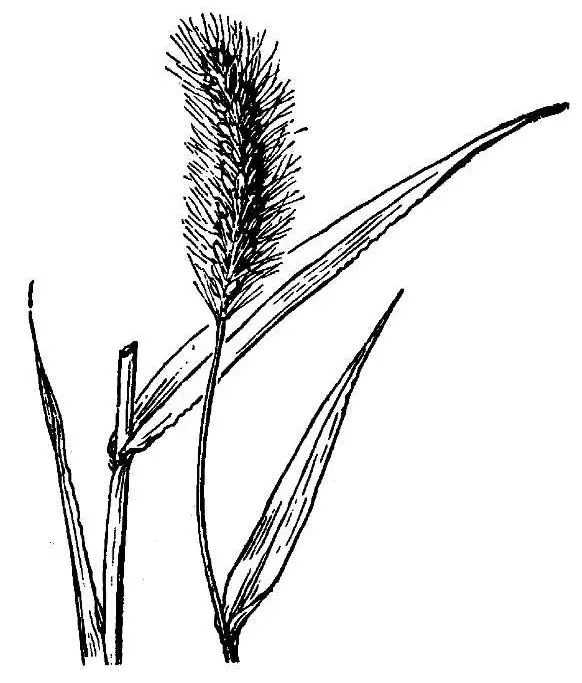
Green Foxtail drawing showing leaf and how it attaches to the stem. (USDA-NRCS PLANTS Database / Hitchcock, A.S. (rev. A. Chase). 1950. Manual of the grasses of the United States. USDA Miscellaneous Publication No. 200. Washington, DC.)
Yellow Foxtail (Setaria glauca or Setaria lutescens or Setaria pumila). Setaria glauca often refers to the cultivated variety of this plant, or can be a synonym. Known also as: Yellow Bristlegrass, Golden Foxtail, Foxtail millet, Pale Pigeongrass, Summergrass, Wild Millet and Pearl Millet. And, this one has a ridiculous number of Latin names as well on top of the three above: Pennisetum glaucum, Panicum pumilum, Panicum imberbe var. pumilum, Setaria glauca var. pumila, Chaetochloa lutescens and others! This is the worst naming mess I've seen. That said, it does point out this is one well studied plant.
The flower spikes when immature have yellow bristles with green center and are upright - they don't nod over like the Green or Giant Foxtail. Grain is good tasting fresh before drying, and good for drying for later use. This one tastes most like commercial Millet you find at health food stores, but in my experience is not as nutty tasting as Green Foxtail, but the difference is small.
- USDA Plant Hardiness Zone: no data, but grows almost everywhere crops are grown (More information on hardiness zones).
- Soil pH: no data, but does very well on neutral to slightly alkaline soils from observation
- Plant Size: About 30-100 cm (1 to 3 feet) tall with multiple culms (stalks) from the base at the ground.
- Duration: Annual
- Leaf Shape: Long, narrow, grass leaf blades
- Leaf Phyllotaxis (Arrangement) on branch: Alternate
- Leaf Size: (8 inches) long by (1/2 inch) wide
- Leaf Margin: Entire (smooth edged)
- Leaf Notes: Early in the season the color of the leaves is green with a blue hue. Very common to see these leaves twisted.
- Flowers: Flower spike do not nod over - they are upright. Up to 12.5 cm (5 inches) long spikes that are bottle brush shaped on the top of each culm. The bristles that stick out and give the bottle brush look are a distinct yellowish-golden color when compared to other Bristly Foxtails.
- Fruit: The whole spike turns a straw-tan when mature. The grain is tan to yellowish-tan to light brown, oval, flattened, and bigger than the Green Foxtail Grain. Taste is very good fresh before drying, and good to use as a flour or cooked grain.
- Stems: Light green, hairless, round
- Habitat: Almost anywhere there is disturbed ground. They seem to do very well in disturbed clay based soils. They handle drought very well.
Web Resources:
- Pictures on the web here (Google images) and here (Bing images).
- Interactive USDA distribution map and plant profile here.
- The Biota of North America Program (BONAP) distribution map here. BONAP map color key here.

Yellow Foxtail up close.
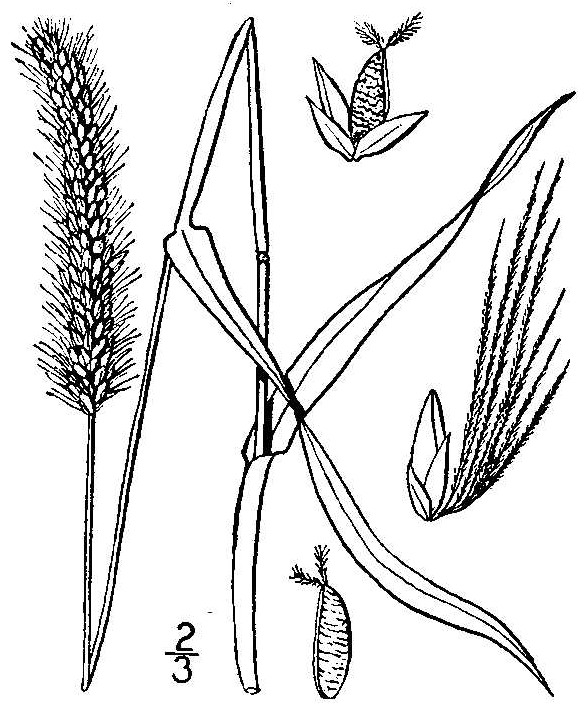
Yellow Foxtail drawing. (USDA-NRCS PLANTS Database / Britton, N.L., and A. Brown. 1913. An illustrated flora of the northern United States, Canada and the British Possessions. 3 vols. Charles Scribner's Sons, New York. Vol. 1: 165.)
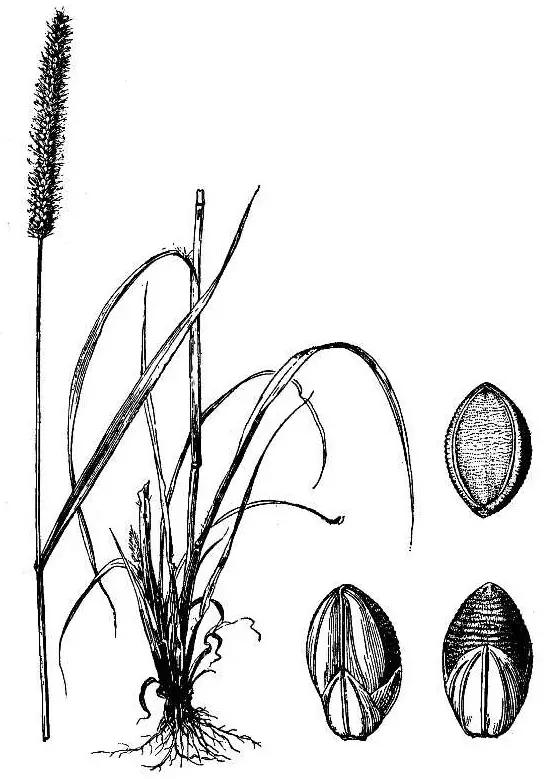
Yellow Foxtail drawing with excellent detail on grain. (USDA-NRCS PLANTS Database / Hitchcock, A.S. (rev. A. Chase). 1950. Manual of the grasses of the United States. USDA Miscellaneous Publication No. 200. Washington, DC.)

Search Wild Foods Home Garden & Nature's Restaurant Websites:
Share:
Why does this site have ads?
Originally the content in this site was a book that was sold through Amazon worldwide. However, I wanted the information to available to everyone free of charge, so I made this website. The ads on the site help cover the cost of maintaining the site and keeping it available.
Google + profile
Source: https://wildfoodshomegarden.com/Foxtail.html
0 Response to "Easy to Draw a Foxtail Plant Easy to Draw Marsh Grass"
Post a Comment